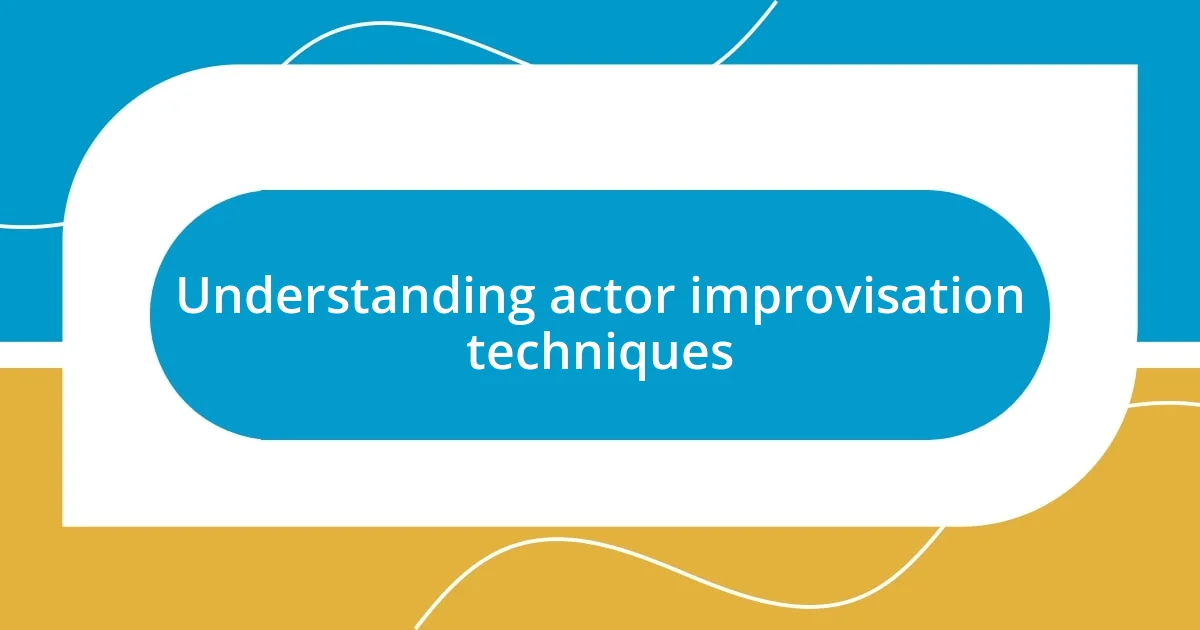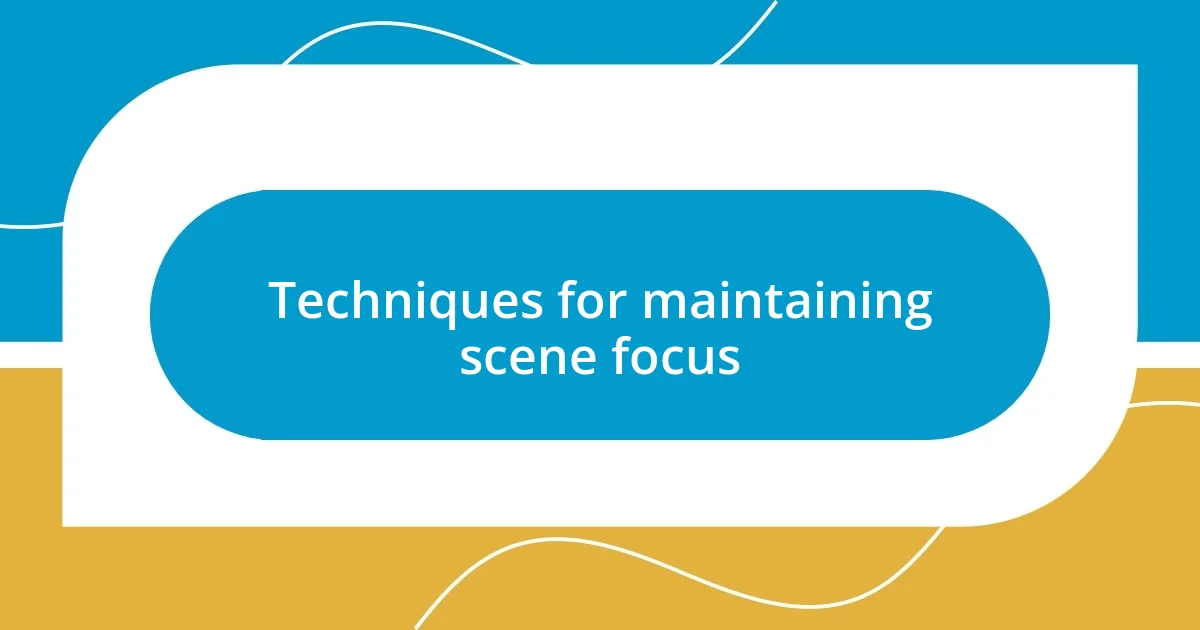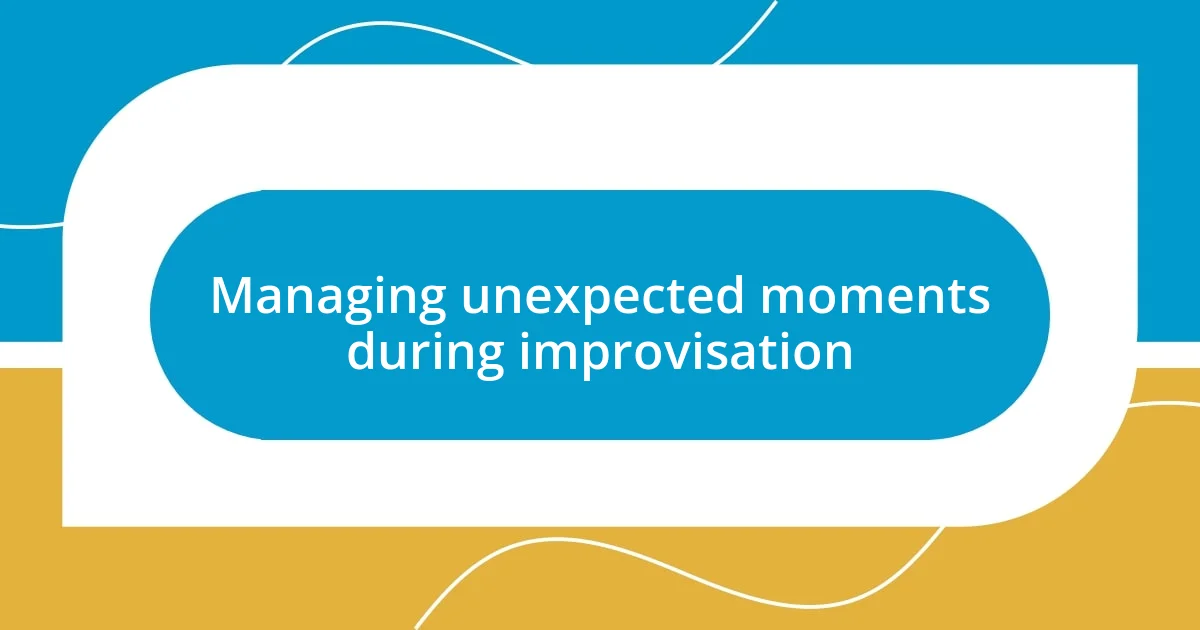Key takeaways:
- Key improvisation techniques include the “Yes, and…” principle and active listening to enhance collaboration and emotional connection on stage.
- Preparation is essential, involving character development, skill rehearsals, and mental readiness to allow for spontaneous creativity during performances.
- Emphasizing physicality, status shifts, and embracing unexpected moments can maintain scene focus and create genuine, engaging interactions with the audience.

Understanding actor improvisation techniques
Understanding actor improvisation techniques involves recognizing that spontaneity can be a powerful tool. I remember my first experience with improv; the thrill of stepping onto the stage without a script made my heart race. When I think back, I realize that it’s not just about being funny or clever; it’s about being genuinely present in the moment and reacting to what’s happening around you.
One core technique is “Yes, and…” This principle encourages actors to accept their scene partner’s ideas and build upon them, fostering collaboration. I’ve often found that when I embrace this approach, I create richer and more dynamic scenes. Does it feel scary at first to agree with a wild idea? Absolutely! But diving in opens up paths I never considered, allowing the creativity to flow.
Another important aspect is listening—truly listening. During a workshop, I once missed a key line because I was too focused on my own response. This led to a confusing scene where I felt disconnected. Afterward, I learned that genuine engagement with fellow actors not only enhances the scene but also deepens emotional connections. How often do we experience moments where silence speaks louder than words? In improv, that silence can be a beautiful space for discovery.

Importance of preparation for improvisation
Preparation for improvisation might seem counterintuitive since improv thrives on spontaneity. However, in my experience, laying the groundwork can profoundly enhance both spontaneity and creativity. I remember my first improv class where we practiced warm-up exercises. These activities not only broke the ice but also primed my mind, making it easier to engage and react dynamically when the time came to perform.
Having a solid understanding of basic contexts, characters, and scenarios adds depth to an improvised scene. I often spend time thinking about potential characters and backstories outside of rehearsals. This prepares me for any situation that may arise on stage, allowing me to draw on that rich tapestry of ideas. It’s exhilarating to pull in those nuances, making each moment feel authentic, as if the story is unfolding in real-time.
Lastly, rehearsing core skills—like physicality and vocal range—develops a toolkit ready for any improv challenge. I recall a night where I struggled to convey a character due to my limited vocal warm-ups. I felt frustrated, thinking how a little preparation could have unleashed my creativity instead of confining it. By honing these skills ahead of time, I empower myself to fully embrace the unpredictable nature of improvisation, transforming potential anxiety into exciting possibilities.
| Aspect | Importance |
|---|---|
| Mental Readiness | Preparation fine-tunes your mind to respond instinctively. |
| Character Development | Having context enriches your improvisation, leading to authentic storytelling. |
| Skillset Enhancement | Practicing core skills liberates you to fully engage with the scene. |

Encouraging spontaneity in performances
Encouraging spontaneity in performances is about creating an environment where actors feel free to take risks. I’ve seen that when I approach a scene without the pressure to be perfect, the magic happens. There’s a rush that comes from allowing an idea to unfold naturally. I remember a particular rehearsal when a fellow actor went off script, incorporating my character’s unexpected response to a silly prop. Instead of the usual line, we found ourselves laughing uncontrollably. That organic moment transformed the scene into something fresh and unforgettable.
To cultivate this spirit of spontaneity, consider the following practices:
- Create a Safe Space: Encourage vulnerability in your team by fostering trust among performers.
- Embrace Mistakes: Remind everyone that errors can lead to unexpected laughter or heartfelt moments.
- Mix Up the Routine: Occasionally shake up rehearsals with new exercises that break established patterns.
- Use Improv Games: Introduce games that promote quick thinking and creativity, making spontaneity feel second nature.
- Celebrate Unique Choices: Acknowledging and praising individual contributions during performances can reinforce the value of spontaneity.
In my journey, I’ve learned that spontaneity isn’t merely a skill—it’s a mindset. The next time you step onto the stage, remember to breathe, listen, and allow yourself to be surprised. In doing so, you might uncover the most genuine connections and stories that resonate with both you and your audience.

Techniques for maintaining scene focus
Maintaining scene focus is pivotal in improvisation, and one effective technique I’ve found is to actively listen to my fellow performers. I remember a moment when I was performing a scene, and my partner dropped an unexpected line. Instead of sticking rigidly to my prepared response, I tuned in fully, which not only enhanced our interaction but also kept the momentum of the scene alive. Have you ever experienced how listening transforms the energy on stage? It truly creates an atmosphere where everyone is attuned to each other.
Another powerful method is to commit to physicality. Engaging your body in the scene can anchor you when words escape you. For instance, during a recent improvisational session, I focused on my character’s posture and gestures, and it led to unexpected moments that drove the narrative forward, keeping our audience mesmerized. It’s fascinating how embodying a character can provide clarity and maintain focus, isn’t it?
Finally, I think using status shifts can be an excellent way to keep the scene dynamic. Playing with who has the power or control not only adds depth but also requires everyone to stay alert. I recall a scene where I took on a more submissive role, and it turned the tables on my scene partner, who adapted remarkably. This fluidity helped us both maintain focus on the immediate actions rather than worrying about the script. How often have you seen a scene thrive because of unexpected shifts like this? The beauty of improv lies in these moments of genuine connection, which not only engage the actors but also keep the audience eagerly anticipating what will happen next.

Managing unexpected moments during improvisation
Managing unexpected moments during improvisation can be both thrilling and daunting. I recall one instance where mid-scene, I tripped over a prop. Instead of panicking, I used that stumble as a pivot point, dramatically collapsing in surprise and innocence, leading to unforeseen laughter and a strengthened bond with the audience. Have you ever noticed how such flukes can morph into the heartbeat of a performance?
It’s crucial to embrace the unpredictable with a light heart. I once participated in a long-form improv where my partner spontaneously introduced a hidden character—a cat! Instead of chalking it up as an oddity, I rolled with it, pretending to be fascinated and terrified. That unexpected twist not only revitalized our energy but also sparked a delightful frenzy that captivated our viewers. In moments like these, how could one possibly resist the allure of spontaneity?
Ultimately, staying present is key. I always remind myself to focus on what’s happening right in front of me. There was a time when I was given an unanticipated cue that threw me off guard. Instead of freezing, I took a breath and responded genuinely to my scene partner. By connecting with the moment, I transformed what could have been a blunder into a defining moment of authenticity in our performance. Isn’t it intriguing how the best memories on stage often come from those unexpected turns?














